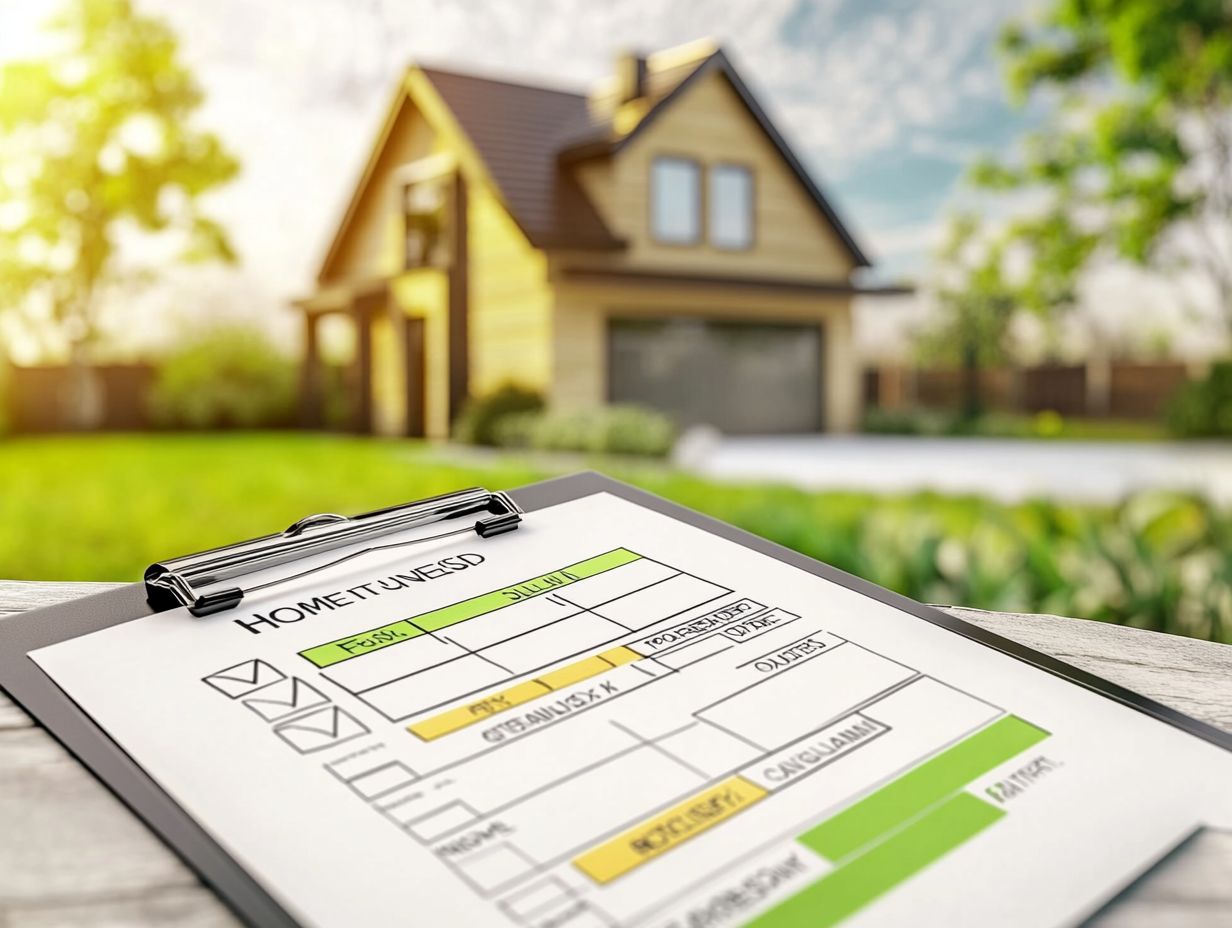5 Must-Have Features in Home Insurance Policies
When safeguarding your home, grasping the details of your insurance policy is essential. Home insurance serves not merely as a safety net; it acts as a robust shield against a multitude of risks.
Let s dive into the must-have features of home insurance that will protect your home and peace of mind! This guide delves into five essential features that every homeowner should seek in their policy, ranging from comprehensive coverage to personal property protection. Additionally, it addresses critical questions regarding policy types, coverage amounts, common exclusions, factors influencing premiums, and tips for saving money.
By the conclusion, you’ll be well-prepared to make informed decisions about your home insurance needs.
Contents
Key Takeaways:

- Comprehensive coverage is essential in protecting your home from a wide range of risks, including natural disasters, theft, and liability. It provides peace of mind and financial security for homeowners.
- Adequate liability coverage is crucial in protecting you from legal and medical expenses if someone is injured on your property. It also covers damages caused by you or your family members to others’ property.
- In the event of a disaster, additional living expenses coverage will cover temporary living expenses such as hotel bills and food costs. This can be a lifesaver for homeowners who are temporarily displaced from their homes.
1. Comprehensive Coverage
Comprehensive coverage in home insurance is crucial for you as a homeowner seeking protection against a wide range of risks. To enhance your policy, consider these 5 ways to customize your home insurance policy. It ensures that your financial investment is shielded from potential losses caused by unforeseen incidents.
This grants you peace of mind and financial security in various circumstances.
Unlike other types of insurance that may focus exclusively on specific risks like fire or flooding, comprehensive coverage provides a more extensive safety net. It encompasses damages from vandalism, storms, and even accidents that occur on your property.
You ll appreciate the proactive nature of comprehensive policies, as they not only safeguard against major disasters but also offer financial assistance during mishaps that may not be immediately evident.
The specifics of comprehensive coverage can vary significantly among different insurance providers. Each company presents unique terms and conditions tailored to meet your needs, highlighting the importance of comparing policies to find the best fit for your individual situation.
2. Adequate Liability Coverage
Adequate liability coverage is a cornerstone of homeowners insurance. It protects you from potential legal claims arising from injuries or damages on your property, ensuring your financial responsibilities are managed effectively.
This type of coverage provides financial protection against accidents, reducing the impact of incidents that could lead to significant financial loss.
You have the flexibility to choose from a variety of coverage limits tailored to your needs, from basic plans to more comprehensive options that offer enhanced protection.
Incorporating this liability coverage into your insurance policy not only grants you peace of mind but also shields you from common claims, like slip-and-fall incidents or damages caused by pets. With sufficient coverage in place, you can avoid crippling costs, underscoring the crucial role of liability coverage in responsible homeownership.
3. Additional Living Expenses Coverage
Additional living expenses coverage is an essential element of homeowners insurance. It offers you financial relief for temporary housing and living costs if your home becomes uninhabitable due to covered events like fires or severe storms.
This coverage typically takes care of necessities such as hotel stays, meals, and other essential living expenses that may arise during this disruption.
For example, if a family faces a fire that makes their home unlivable, this provision ensures they can maintain their standard of living while awaiting repairs.
It’s a critical feature of a comprehensive insurance policy, alleviating the financial burden that accompanies unforeseen relocations, including 5 things you didn’t know about home insurance.
You should review your policy meticulously, as specific requirements and limits may apply. This includes caps on daily expenses and the duration of benefits, ensuring you’re thoroughly protected during times of crisis.
Review your home insurance policy today to ensure you’re fully covered!
4. Replacement Cost Coverage

Replacement cost coverage in homeowners insurance is crucial for restoring your home to its original condition after a loss. It provides the funds to replace damaged items without factoring in depreciation, offering you better protection than actual cash value policies.
This coverage contrasts with actual cash value, which takes depreciation into account and might leave you underinsured after a disaster. Knowing the differences between these options can impact your financial recovery.
Dwelling coverage, usually determined by your home’s appraised value and local building costs, is essential for establishing the right level of coverage.
By choosing replacement cost coverage, you generally benefit from a quicker and more comprehensive recovery process, ensuring better protection for your investment.
5. Personal Property Coverage
Personal property coverage is an essential part of homeowners insurance, designed to protect your belongings from risks like theft, fire, and other perils. This coverage helps safeguard your unique exposures in unexpected situations.
This coverage typically includes items like furniture, electronics, clothing, and personal valuables, giving you peace of mind that these essentials can be replaced if they’re damaged or lost.
When it’s time to file insurance claims for your personal items, documenting your possessions is crucial. Take photos and keep receipts to streamline the evaluation process.
To assess the value of your belongings, create a detailed inventory that considers purchase price, condition, and current market value. This way, you ensure your coverage accurately reflects what is at stake if a claim arises.
What Is Home Insurance and Why Is It Important?
Home insurance is important financial protection for homeowners, offering 6 benefits that safeguard your dwelling and personal belongings from various risks, including natural disasters and liability claims.
This coverage helps you meet insurance requirements and secures your financial future, granting you invaluable peace of mind. Understanding the different types of home insurance is key, as coverage and costs can vary significantly.
Your options include:
- Homeowner’s policies
- Renter’s insurance
- Specialized plans for specific threats like flooding or earthquakes
Act now to familiarize yourself with these choices and ensure your coverage meets your unique needs! It’s essential to understand that having adequate insurance protects your valuable assets and provides legal liability coverage if someone gets injured on your property.
Exploring the specifics of these policies empowers you to make informed decisions and enhance your overall protection.
What Are the Different Types of Home Insurance Policies?
Homeowners insurance provides a variety of policies, each designed to meet specific needs. You might encounter options like HO-1, HO-2, HO-3, HO-4, HO-5, HO-6, HO-7, and HO-8, which include important details such as the key features of comprehensive home insurance, all offering essential coverage for property owners and renters.
It’s important to know these differences so you can choose the best policy for your situation. For instance, the HO-3 policy is often regarded as the most comprehensive, covering a broad range of perils.
In contrast, the HO-4 is tailored for renters, protecting their personal belongings without covering the structure itself. If you want even broader coverage, the HO-5 policy may be the answer, typically at a higher premium.
For those with older homes, the HO-8 policy could be especially beneficial, as it addresses the specific needs of such properties. With these tailored coverage features, you can make informed decisions that enhance your financial security and peace of mind.
How Can a Homeowner Determine the Right Coverage Amount?

Determining the right coverage amount for your homeowner’s insurance is crucial for ensuring you have adequate financial protection. This process involves assessing various risk factors associated with your property and personal circumstances. Secure insurance quotes that are tailored to your specific needs.
Start by conducting a thorough property valuation. This should consider the current market value of your home and any unique features that may impact its worth.
Know your risk factors, like natural disasters or crime rates, to make informed decisions. Obtaining quotes from multiple insurance companies provides valuable insights into different coverage options and premiums.
By doing this, you can find the best fit for your financial security, especially in the face of unforeseen circumstances.
What Are the Common Exclusions in Homeowner’s Insurance Policies?
Understanding the common exclusions in homeowner’s insurance policies is essential, as these gaps can leave you vulnerable to significant financial loss. Additionally, implementing the top 5 home security features that lower insurance can help protect your investment.
Typical exclusions often encompass floods, earthquakes, and certain business-related damages.
If you live in a high-risk area prone to natural disasters or operate a home-based business, these coverage gaps can be particularly concerning. Don’t wait! Standard policies often leave you unprotected from unexpected events such as mold damage, acts of terrorism, or maintenance-related issues like wear and tear. To better safeguard your unique property, consider exploring 5 types of home insurance for unique properties.
Explore supplemental options! Flood insurance can fill in the gaps and prepare you for the unexpected.
What Are the Factors That Affect Homeowner’s Insurance Premiums?
Several factors influence your homeowner’s insurance premiums, including your property’s location, claims history, and its value. These elements significantly shape how insurance companies determine your costs.
Depending on where you live, risks like natural disasters, crime rates, and the distance to fire services can considerably impact your premium. Different insurance companies may use distinct rules to set prices based on their risk assessment models.
Manage your premiums effectively. Bundle your insurance policies, upgrade your home security features, and maintain a solid credit score. These strategies help you negotiate better rates and deepen your understanding of insurance costs.
How Can a Homeowner Save Money on Homeowner’s Insurance?
Save big on homeowner’s insurance by exploring discounts and comparing options. Adjusting coverage limits can help you strike the ideal balance between cost and protection.
Invest some time in researching the discounts that insurance providers offer. You might find deductions for bundling multiple policies or having a security system in place.
Create a comprehensive list of various insurance companies and obtain quotes to secure the best possible deal.
Evaluate the coverage details. Adjust your policy limits thoughtfully to reflect your property’s actual value while still accommodating your budget.
Revisit your policies periodically to find new savings, as changes to your home or local regulations could unveil new opportunities.
Frequently Asked Questions

Get your quotes today and protect your home with the right insurance!
What are the 5 must-have features in home insurance policies?
Five essential features in home insurance policies are property coverage, liability coverage, personal property coverage, loss of use coverage, and additional living expenses coverage. Before purchasing a policy, it’s wise to consider the 5 things to know before buying home insurance, as these features protect your home and belongings from unexpected events.
What is property coverage and why is it important?
Property coverage protects your home’s structure, including walls, roof, and foundation, from risks like fire and theft. To choose the right policy, consider these 5 tips for selecting home insurance types. This coverage is crucial for avoiding costly repairs.
Why is liability coverage necessary in a home insurance policy?
Liability coverage protects you from financial responsibility if someone gets injured on your property. It covers legal fees, medical costs, and settlements, preventing financial strain.
What does personal property coverage include?
Personal property coverage protects your belongings inside your home, including furniture and electronics. It can also cover items outside your home, like those in your car or luggage while traveling.
How does loss of use coverage work?
This coverage helps pay for living expenses if your home is uninhabitable due to events like a fire. It covers costs like hotel bills and meals, helping you maintain your lifestyle during repairs.
What are additional living expenses coverage?
Additional living expenses coverage goes beyond basic living costs when you re displaced. It helps with extra expenses like transportation, pet boarding, and increased utility bills, easing the financial burden of being away from home.






